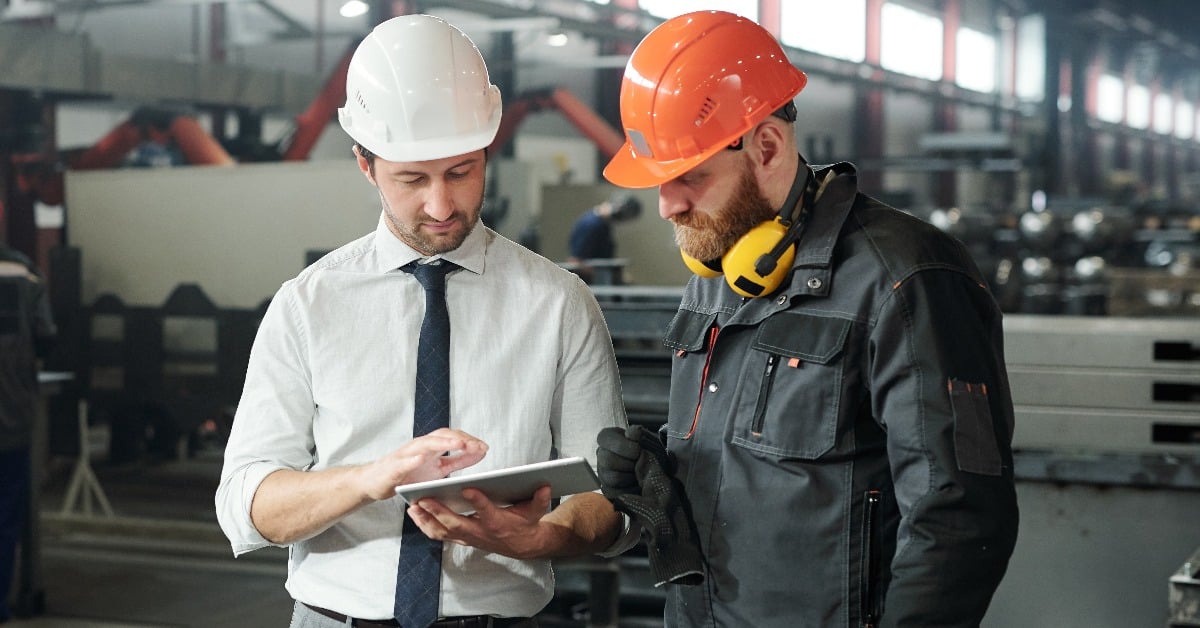Constant disruptions to the supply chain. Shifting consumer demand. The struggle to find and keep employees.
Sound familiar? For those of us who operate in today’s enterprise landscape it certainly is. That’s why it’s more important to find efficiencies in every corner—including in the ways that employees communicate with each other and with customers.
And that’s why so many businesses today are increasingly supplementing or trading in old radio systems for digital walkie-talkies.
.jpg?width=8256&name=young-master-hardhat-bearded-engineer-discussing-technical-sketch-display-tablet-factory-workshop%20(1).jpg)
How digital push-to-talk increases operational efficiency and productivity
1) One-touch communication
A user can instantly connect to another user or a specified group by tapping a smartphone or tablet uploaded with a push-to-talk app.
The connection is so quick and simple—there’s no need to search for and then dial phone numbers—and technology is compliant with the FMCSA’s one touch rule. This means drivers can safely use push-to-talk without needing to pull to the side of the road. Keep on trucking!
2) Instantly connect with the right people
Digital push-to-talk offers the easy creation of channels.
A manager at a furniture retailer may have a team of salespeople spread across a vast showroom floor but need to urgently communicate that a popular kitchen appliance is back in stock. By tapping the “kitchens” channel, the manager can instantly connect to all sales members working in that department and relate the news.
Or if there’s a snowstorm that’s worse than expected, the manager might use a different channel dedicated to the admin team to discuss whether the store should close early. There’s no running around to find the right person, or leaving the customer behind on a showroom floor. Just simple, instant connections to boost efficiency and increase the likelihood of making a sale.
3) Eliminates radio fatigue
A common problem with traditional walkie-talkie radios is that workers who use them suffer from “radio fatigue.” Since all communication happens on a single channel, the chatter is nonstop and many people tune it out, which makes it difficult to connect with them when they’re actually needed.
With digital push-to-talk channels, users only receive messages meant specifically for them, so radio fatigue is no longer an issue. For example, a driver will only be contacted by dispatch when a message is about their specific route or delivery.
4) Unobtrusive
Digital push-to-talk apps help workers keep their focus where it belongs and deliver the highest quality customer care.
A nurse at an emergency room intake desk might suspect the person she’s admitting needs immediate attention. The nurse can keep her eyes trained on the patient while subtly tapping the app and quietly communicating with the emergency cardiac team about the admission.
Similarly, a manager in an upscale restaurant can handle a customer complaint by keeping eye contact with the customer while communicating the problem with the kitchen.
5) Works from anywhere
One of the greatest benefits of digital push-to-talk is that it works from anywhere. Unlike radio, which requires access to a local radio frequency, all you need is a cell signal or Wi-Fi to connect with other users anywhere in the world! The range is unlimited.
6) Crystal clear sound
Traditional radio systems are prone to static and poor sound quality due to weak signals from radio towers. The radio signal can be disrupted by dense urban buildings or lack of towers in rural areas. But since digital push-to-talk works on a cell signal, the sound quality is excellent and unaffected by the surroundings.
7) Private
Anyone with a scanner can eavesdrop on a conversation taking place with traditional radios. But for many businesses, confidentiality is key. Because digital push-to-talk doesn’t run on a radio signal, there’s no way for scanners to eavesdrop on private business conversations.
8) Safety
One of the best features of push-to-talk is that it often includes emergency alert technology.
What does this mean in practical terms? A driver who runs into trouble on the road can let dispatch know there’s a problem with a single tap. Dispatch will see the GPS location of the driver and can immediately send help.
Or, a retailer confronted by an angry customer can quickly and subtly tap the emergency alert button so that security will hurry to the exact location. In this way, workers with digital push-to-talk on their devices are never truly alone.
9) Intuitive interface
Digital push-to-talk technology is simple to use. Companies who adopt it can train their team members on how to use it in just a few minutes.
It’s not uncommon for the commander at a disaster site to quickly show all emergency responders who arrive on the scene how to use digital push-to-talk.
This way, police, ambulance, and search and rescue—no matter where they’ve arrived from—can get on the same communication platform within a few minutes.
A passion for push-to-talk technology
Often, people who make the switch to digital push-to-talk don’t just like it. They love it.
And they often become passionate advocates for the efficient communication technology that frees them up to focus on their work, increase collaboration with colleagues, and deliver better results for their companies.
Learn more about how Zello can benefit your organization.

